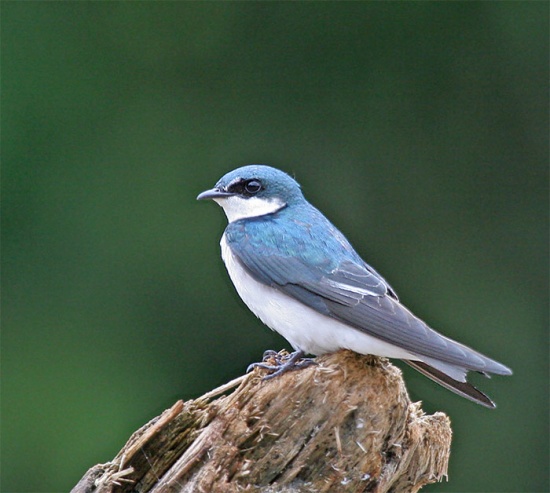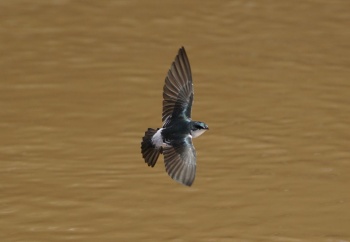- Tachycineta albilinea
Identification
11–12 cm (4¼-4¾ in)
Bill: small and black
Male
- Iridescent bluish-green upperparts
- White underparts and rump
- Black tail and flight feathers
- Thin white stripe from bill to above eye
Female: duller
Juvenile
- Dull greyish-brown upperparts
- Greyish-brown (washed white) underparts
Distribution
They are froun from the lowlands of northern Mexico through Central America to Panama.
Accidental vagrant to Florida (1 recent record).
Taxonomy
This is a monotypic species[1].
Tumbes Swallow was considered a subspecies of Mangrove Swallow, but the closest relative of Mangrove Swallow is actually White-winged Swallow.
Habitat
Still open water, coastal beaches and mangroves.
Behaviour
Breeding
They construct a bulky cup nest in cavities near water. The clutch contains 3-5 white eggs which are incubated for 17 days. The nestlings are fed by both parents for 23-27 days to fledging. They usually raise a second brood.
Diet
Their diet consists mostly of flying insects, particularly ants; beetles and bugs and includes large species such as dragonflies and bees.
Vocalisation
- Song: a soft trill
- Call: a rolled jeerrrt and “chiri-chrit”
References
- Clements, J. F., T. S. Schulenberg, M. J. Iliff, S. M. Billerman, T. A. Fredericks, B. L. Sullivan, and C. L. Wood. 2019. The eBird/Clements Checklist of Birds of the World: v2019. Downloaded from http://www.birds.cornell.edu/clementschecklist/download/
- SACC baseline read September 2009
- Turner, A. (2020). Mangrove Swallow (Tachycineta albilinea). In: del Hoyo, J., Elliott, A., Sargatal, J., Christie, D.A. & de Juana, E. (eds.). Handbook of the Birds of the World Alive. Lynx Edicions, Barcelona. (retrieved from https://www.hbw.com/node/57705 on 29 February 2020)
Recommended Citation
- BirdForum Opus contributors. (2025) Mangrove Swallow. In: BirdForum, the forum for wild birds and birding. Retrieved 14 May 2025 from https://www.birdforum.net/opus/Mangrove_Swallow





